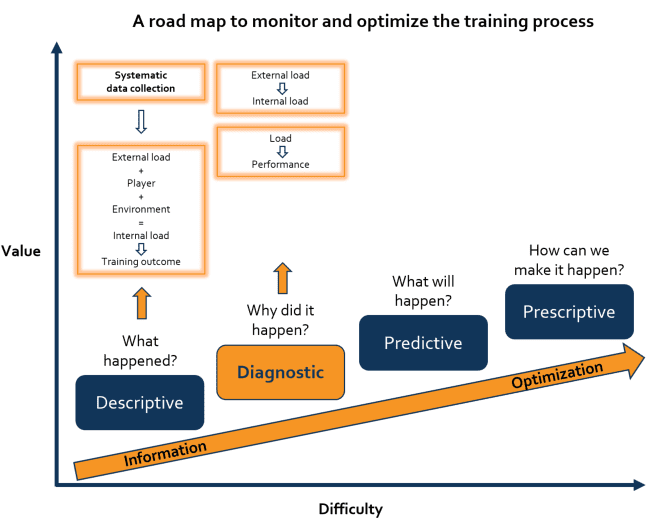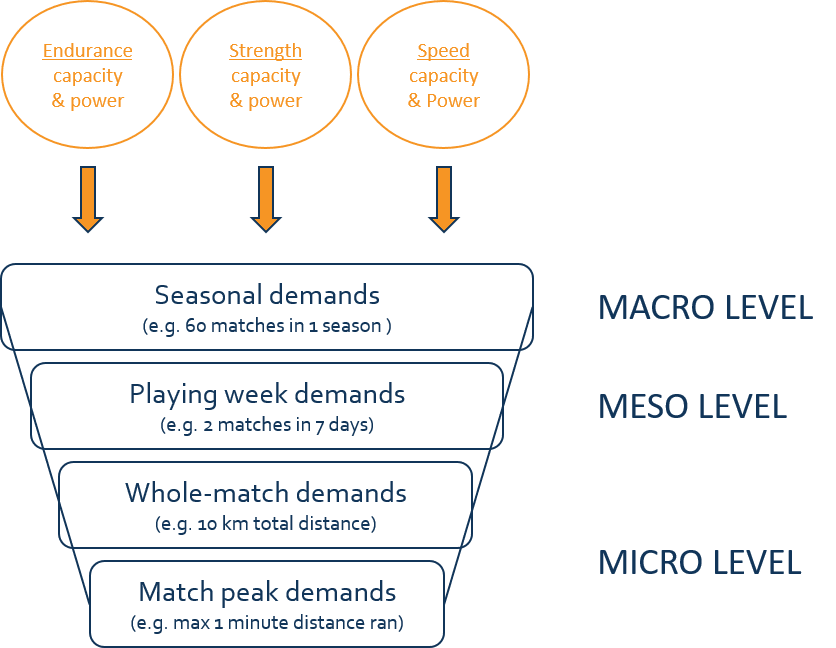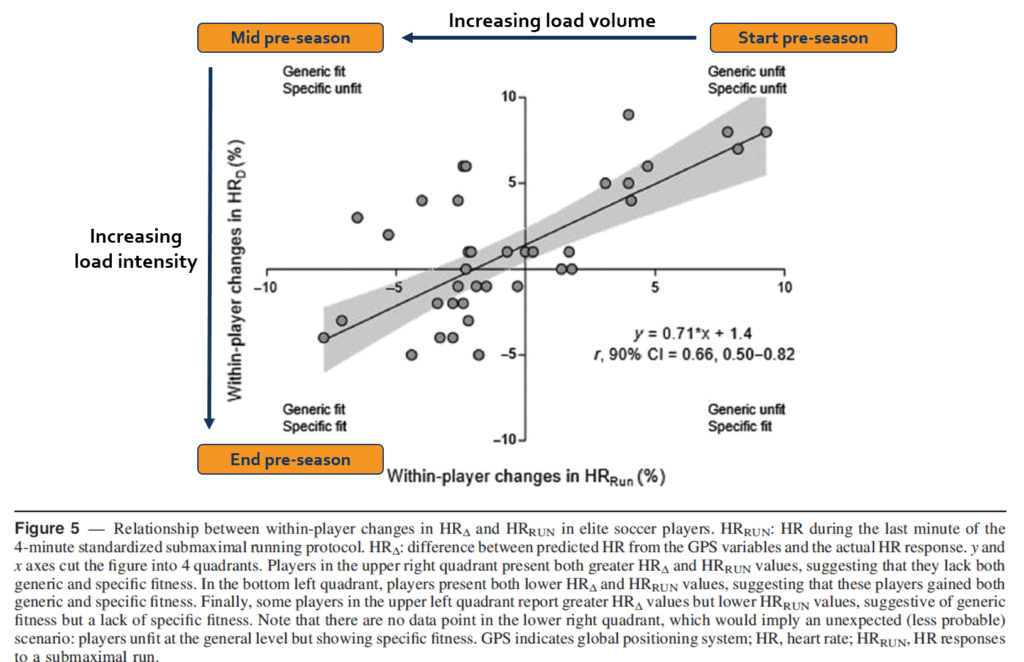Monitoring the training process in team sport
In the previous blog post (link to blog), the relationship between load and performance was explained using the fitness-fatigue model of Banister et al. (1975). We discussed the benefits of performance modelling based on the balance between fitness and fatigue responses to training. In addition, we acknowledged the limitations inherent to the fitness-fatigue model.
Therefore, we advised combining performance modelling with standardised testing. The difference between the ‘slow’ fitness and the ‘fast’ fatigue component is also visible in the organisation (frequency and timing) of standardised testing. Fitness may be frequently tested during pre-season with less frequent follow-up measurements during in-season, while fatigue may be tested daily or weekly to measure players’ responses to the last training session or match. In this blog, we provide some information about the load-fitness relation. In the next blog, we will cover the relation between load and fatigue.

TopSportsLab launched a first PhD project in 2014. At that time, the application of monitoring technology was clearly making its way into professional football. This was followed by several studies describing players’ training and match load using external and internal load indicators (link 1 to article, link 2, link 3). Despite the abundance of measurement tools and descriptive possibilities of load indicators, diagnostic research examining fitness responses to training and match load in professional football was still limited and unclear. This was summarised in 2017, by our colleagues Arne Jaspers, Michel Brink, Steven Probst, Wouter Frencken and Werner Helsen, in a systematic review article in ‘Sports Medicine’ (link to article). In the meantime, more studies have examined this relationship thereby providing more insights.
To optimise the players’ fitness, it is important to understand the physical demands of professional football. These can be assessed on different levels (figure 2). On the micro level, one can distinguish between match peak demands and whole-match demands. While match peak demands describe the most intense periods during the game (Delaney et al, 2018, link to article; Whitehead et al, 2018, link to article; Ferraday et al, 2020, link to article), whole-match demands provide information about the overall load of the match (Barnes et al, 2014, link to article; Dalen et al, 2019, link to article). Information about these demands can be used to improve the specificity of the training program. Subsequently, the demands of the training programs itself can be described at the meso level. It may, for example, be useful to quantify the weekly loads or summarise the loads per periodisation phase (Kelly et al, 2020, link to article). Also, the extent to which players are exposed to congested match schedules can provide useful insight into the load and recovery demands of football (Carling et al, 2015, link to article). In a recent study of Gouttebarge, Brink and Kerkhoffs (2019) (link to article), nearly 40% (n= 543) of the professional football players reported being exposed to insufficient recovery between matches. Additionally, players also complained about playing too many matches per season (macro level). By integrating this information from micro to macro level, practitioners can prescribe and evaluate training programs to prepare their players for the demands of football.

After an off-season period, decrements in endurance, strength and speed performance are reported (Renato Silva et al, 2016, link to article). Therefore, the main build-up of players’ fitness takes place during the pre-season period, which is well described by Lacome and colleagues (2018, link to article). In their study generic physical fitness was monitored, using a 4-minute submaximal running protocol (12 km/h). In addition, football-specific fitness was measured by means of small-sided games, thereby integrating fitness testing in regular training sessions. Both tests used submaximal heart rate responses to a given external load as an indicator of fitness, with lower heart rate responses reflecting a higher efficiency. The study demonstrated a progressive increase in fitness from pre-season to early in-season.
Furthermore, using the combination of both tests, the study also provided evidence about the transition from generic to specific fitness during pre-season, as illustrated in figure 3 (adapted from Lacome and Colleagues (2018, link to article). In this figure, one would expect that players are located in the upper right quadrant at the start of pre-season, revealing a lack of generic and specific fitness after the off-season period. Generic fitness will increase during the first part of pre-season after periods of high volume training at a lower intensity (upper left quadrant), followed by improvements in specific fitness during the second part of pre-season (lower left quadrant). This second part is characterised by a more specific preparation increasing the intensity but lowering the volume of the training sessions. This leads to a restored specific fitness ensuring that the players are ready to meet the competition demands at the start of the season. For more detailed definitions of generic and specific fitness as well as an explanation of this quadrant, we highly recommend reading the paper of Lacome and colleagues (link to article).

During in-season, systematic match exposure causes players’ fitness to be more or less stable. Therefore, the focus of monitoring may be more oriented towards fatigue management during in-season. However, care must be taken with regard to the players that are lacking match exposure such as substitutes or young promising players. These players are often underloaded during in-season and thereby not sufficiently prepared for the match demands. In 2016, an article was published by Anderson et al. (link to article). In this article, the authors examined differences in training and match load between:
- starters (players starting in > 60% of the matches),
- fringe players (players starting in 30 – 60% of the matches) and
- non-starters (players starting in < 30% of the matches).
No differences in total duration and distance were found, however, clear differences were found for moderate to high-speed running (> 14.4 km/h and 19.9 km/h) and sprint distance (> 25.2 km/h). Starters covered more distance at these high-intensity zones compared to both fringe players and non-starters. These differences were mainly caused by lower match exposure and corresponding physical demands. Given the importance of high-intensity training to the development of football-specific fitness, lower exposure to high-intensity loads may cause a substantial underloading. Therefore, it is important to closely follow-up fringe players and non-starters training load to compensate for the missing match exposure. Practical guidelines for prescribing high-intensity running can be found in an article by Martin Buchheit in Sports Performance Science Reports (link to article).
Similar to fringe players or non-starters, elite youth players may lack playing time during their transition to the first team to further develop or maintain their fitness. In this respect, TopSportsLab is currently conducting a study in which the differences in external load will be examined between the first team and elite youth players. This will be done with regard to different types of playing weeks (congested and non-congested). More information will follow!
The abovementioned insights may provide practitioners with a framework to periodise their seasonal training sessions. To evaluate changes in fitness in response to your periodisation, appropriate statistics are required to distinguish between real training effects and measurement noise. For a clear explanation regarding this matter, we would like to refer to a blog of Shaun McLaren (link to blog). For our Dutch readers, we also refer to the blog of Wouter Frencken and Michel Brink (link to blog). In short, the first step is to define the measurement noise. This noise can be attributed to:
- The measurement error of the testing system,
- Random biological variation,
- Environmental factors or
- Motivation and technique of the player.
By considering this noise, threshold values can be established as ‘minimal detectable change’. In addition, practitioners may also include a ‘smallest worthwhile change’ threshold to develop cut-offs for relevant training effects. These thresholds may be based on the within or between-players standard deviation, previous literature or common sense. Finally, the size and likelihood of the training effect may be assessed using the magnitude-based decision (MBD) method, developed by Batterham & Hopkins (link to article). Although the MBD method recently received criticism in the scientific community, TopSportsLab believes its practical benefit and will, therefore, aim to integrate this method within their monitoring application. This will support practitioners in detecting relevant fitness changes.
Feel free to contact us at info@topsportlab.com